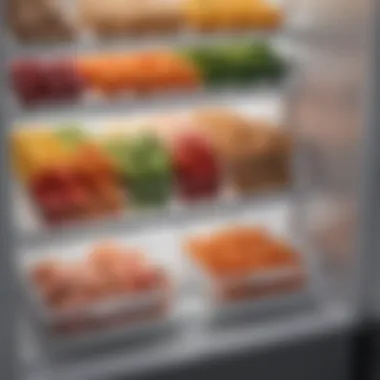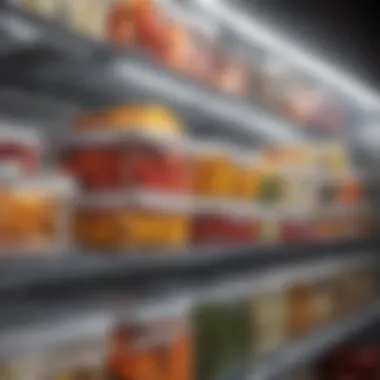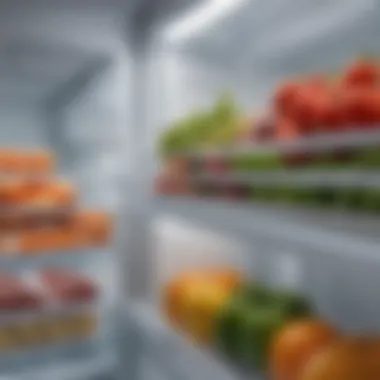The Essential Guide to Freezer Sets for Food Preservation


Intro
Recipe Overview
Brief Description of the Refrigerator Set
The freezer set refers to a collection of containers, bags, and tools utilized to optimally store food in the freezer. Effective usage of these items can enhance the longevity and quality of the stored food. Proper organization leads to easier access and maintains the integrity of the ingredients.
Origin and Cultural Significance
The practice of freezing food has evolved over centuries. In many cultures, freezing is not merely a means of preservation but serves as a method to safeguard culinary traditions. For instance, in Scandinavian countries, fish is commonly stored in brine before freezing, allowing the flavors to mature while maintaining freshness. Understanding the historical context can provide deeper appreciation for the methods we choose today.
Components of a Freezer Set
A freezer set typically consists of several essential components:
- Freezer Bags: These come in various sizes and are designed to withstand low temperatures. Look for bags that are specifically labeled as freezer-safe to prevent freezer burn.
- Plastic Containers: Rigid containers can provide better support for certain items, reducing the risk of crushing. Make sure they have airtight lids.
- Mason Jars: Glass jars are excellent for storing liquids and can also help preserve flavor. However, take care to leave a bit of space at the top to allow for liquid expansion when freezing.
- Labels and Markers: Clear labeling is vital for identifying food items. Use freezer-specific labels to resist smudging when condensation occurs.
Best Practices for Optimal Usage
To maximize the effectiveness of your freezer set, consider the following best practices:
- Cool Food Before Freezing: Always let food cool to room temperature before placing it in the freezer. This prevents condensation, which can lead to freezer burn.
- Portion Size: Divide food into meal-sized portions before freezing. This saves time during meal preparation as you can thaw only what you need.
- Remove Air: Squeeze out as much air as possible from bags and containers before sealing. Air causes freezer burn, impacting food quality.
- Maintain Freezer Temperature: Keep your freezer at 0°F (-18°C) to ensure food remains safe and preserves its quality.
- Regularly Rotate Stock: Use older items first to maintain an organized inventory and reduce waste.
Finale
“Effective food storage is a bridge between culinary art and sustainability.”
For more insights into food preservation, you may explore resources on Wikipedia or Britannica.
Current dialogues on food storage can also be found on forums like Reddit or Facebook.
Prologue to Freezer Sets
Understanding freezer sets is crucial for anyone looking to enhance their food preservation practices. A well-constructed freezer set can significantly prolong the shelf life of various food items, ensuring that quality and taste are maintained. Freezer sets are more than just containers; they are an essential part of modern culinary practices, aiding in meal preparation, leftovers management, and seasonal stockpiling.
By utilizing freezer sets effectively, users can minimize food waste and maximize grocery budgets. The organization and categorization enabled by a good freezer set help in quick meal planning as well.
This section serves as an introduction to the significance of freezer sets. It will explain their definition and purpose, as well as offer insights into their historical context and evolution.
Definition and Purpose
Freezer sets encompass a variety of containers specifically designed for the storage of food in freezing conditions. Their primary purpose is to prevent spoilage by protecting food from air, moisture, and light. Common containers include plastic containers, glass jars, and resealable bags. Each type serves unique needs and preferences.
The design and material of freezer sets are optimized for low temperatures. This helps in preventing freezer burn, which can degrade the flavor and texture of food. The right freezer set is essential for maintaining the overall quality of frozen food.
In practical terms, a freezer set enables home chefs to batch cook, store seasonal produce, and prepare meals in advance. This approach not only saves time but also encourages the use of fresh ingredients at their peak.
Historical Context of Food Preservation
Food preservation dates back thousands of years and has evolved through various methods. Historical practices included drying, salting, and smoking meats. The advent of refrigeration in the 19th century marked a significant shift, allowing for prolonged preservation without sacrificing texture or flavor.
The contemporary freezing techniques we rely on today were developed further in the early 20th century. Modern deep freezers came into existence, making it easier for households to store larger quantities of food efficiently.


Understanding this context emphasizes the importance of food storage practices. It allows us to appreciate how advancements in freezer technology have improved our culinary experiences. The narrative of freezer sets is a testament to our evolving relationship with food safety and management.
Components of a Freezer Set
Understanding the components of a freezer set is crucial for effective food preservation and organization. Each element contributes differently to the storage and longevity of frozen foods. Selecting the right components can directly impact the taste, texture, and safety of the items you wish to freeze. Moreover, proper choice and usage can minimize waste and ensure a more economical approach to food storage.
Types of Containers
Plastic Containers
Plastic containers are a popular choice for freezing food. They are lightweight and are generally designed to be freezer-safe. These containers usually come in various sizes, making them versatile for different types of foods, from leftovers to bulk-prepped meals. One of the key characteristics of plastic containers is their flexibility. This allows them to withstand changes in temperature without breaking.
While plastic containers are beneficial due to their affordability and variety, they can sometimes absorb odors from the food stored in them. Certain types of plastic may not be suitable for long-term storage. Thus, it is essential to choose high-quality, BPA-free options that ensure both safety and durability.
Glass Containers
Glass containers are another effective option for freezing food. They are non-reactive, meaning they won't leach any chemicals into your food, which is a significant advantage over some plastic options. Their airtight seals help maintain freshness and reduce the risk of freezer burn.
One of the unique features of glass containers is their ability to withstand extreme temperature changes, making them suitable for both freezing and reheating. However, glass can be heavier and more prone to breaking than plastic. This makes it less convenient for transporting food, but their clarity allows for easy visibility of contents.
Resealable Bags
Resealable bags present a flexible and often space-saving solution in freezer storage. They are ideal for marinating, portion control, or storing loose items like vegetables and fruits. The key characteristic of resealable bags is their ability to create an airtight seal, which aids in preventing freezer burn effectively.
Their unique feature is that you can squeeze out excess air before sealing, which maximizes storage space. However, it is important to select high-quality bags that are designed specifically for freezing. Thin or low-quality bags can tear or puncture easily, leading to potential spoilage and waste.
Labels and Markers
Proper labeling is vital when using a freezer set. Clear labeling helps keep track of what is stored and when it was frozen. Utilizing labels with the date can prevent food from being kept too long, thus maintaining quality. Using markers that can withstand cold temperatures ensures durability and legibility, minimizing confusion during meal preparation. Additionally, a consistent labeling system can streamline organization and give a structured approach to food storage, enhancing the overall efficiency of your freezing methods.
Selecting the Right Freezer Set
Selecting the right freezer set is crucial for efficient food storage and preservation. The variety of options available can be overwhelming, but understanding what to look for can help streamline the decision-making process. Prioritizing quality, functionality, and suitability to your needs will ensure that the freezer set enhances food longevity and maintains flavor. The right set can save time on meal prep, reduce waste, and make meals more convenient.
Criteria for Quality
Material Durability
Material durability is an essential factor to consider when choosing a freezer set. Durable materials can withstand the cold temperatures and rigorous conditions of a freezer. Common choices include high-density polyethylene and glass. These materials are less likely to crack or warp over time. A notable characteristic of durable materials is their resistance to stains and odors. This benefit makes clean-up easier and keeps food tasting fresh. However, some might prefer lighter materials for ease of handling. Choosing a durable material aligns well with the goal of long-lasting, reliable food storage that avoids unnecessary replacements.
Size Variety
Size variety also plays a key role in selecting a freezer set. Having different container sizes allows for better portion control and accommodates various types of food. Personal preferences and family size directly influence the preferred sizes. For example, single-person households may opt for smaller containers, while larger families could require bigger ones. A unique feature of size variety is its flexibility; it adapts to storage needs as they change over time. However, it's essential to strike a balance to avoid overcrowding your freezer with containers that go unused.
Sealing Mechanisms
Sealing mechanisms represent another critical aspect in freezer set quality. They dictate how well a container can preserve food freshness and avoid freezer burn. Effective sealing mechanisms include locking lids and vacuum sealing options. The main advantage here is that a solid seal prevents moisture loss and keeps air out, which preserves the texture and flavor of food. On the downside, some intricate sealing systems might be harder to clean. Nevertheless, strong sealing mechanisms contribute significantly to achieving optimal food preservation.
Brand Comparisons
When comparing brands, it’s essential to evaluate their reputation based on durability, price, and customer satisfaction. Quality brands typically have a loyal following due to consistent performance. For instance, brands like Rubbermaid and Pyrex are well-regarded for their sturdy construction and user-friendly designs. Reading customer reviews can provide insights into long-term use. Also, consider checking online resources or platforms like Reddit for community discussions on brand experiences. A well-informed brand choice can lead to effective investment in a quality freezer set.
Best Practices for Using a Freezer Set


Using a freezer set correctly is crucial for maintaining the quality and safety of food. The right techniques can enhance the freshness of ingredients and extend their usability, ensuring minimal waste and optimal preservation. When employed effectively, these practices improve both the home cooking experience and the nutritional value of meals.
Preparation of Food for Freezing
Blanching Vegetables
Blanching vegetables before freezing helps in preserving their color, flavor, and texture. This process entails briefly boiling the vegetables and then rapidly cooling them in ice water. The key benefit of blanching is that it deactivates enzymes that can lead to spoilage. This is particularly significant since some vegetables may decline in quality over time, even at freezing temperatures.
A unique feature of blanching is that it maintains the vivid colors of vegetables. Without this step, vegetables may appear dull or lose their vibrant hues over time. While blanching requires extra time before freezing, it is widely recommended as it results in much better quality once thawed.
Portion Control
Portion control is an important practice that optimizes the use of a freezer set. By dividing food into smaller, manageable portions, one can ensure easy access and minimize waste. This practice allows for cooking smaller quantities and also aids in maintaining food quality, as it reduces the frequency of opening the freezer – which can cause temperature fluctuations.
The key characteristic of portion control is that it makes meal planning easier. Each portion can be tailored to specific meals or needs, effectively streamlining daily cooking. One downside might include the initial time spent in dividing food, but this effort pays off in reduction of waste and improved convenience in meal preparation.
Avoiding Freezer Burn
Avoiding freezer burn is essential for keeping food in top condition. Freezer burn occurs when air comes into contact with food, causing dehydration and changes in texture. The primary factor for prevention is proper sealing. Using airtight containers or wrapping food securely can effectively limit exposure to air, preserving the original quality.
The unique feature of minimizing freezer burn is that it keeps food tasting fresh and appealing. This is particularly beneficial for high-quality ingredients. However, it's crucial to ensure that even containers meant to be airtight are checked regularly for defective seals, as this could allow air to enter over time. Keeping vigilant in this aspect strengthens the overall success of food preservation efforts.
Organizing Your Freezer
Organizing your freezer can significantly increase accessibility and efficiency. Start by grouping items logically; for example, keep meats in one area, vegetables in another, and prepared meals in a separate section. Labeling containers and bags can further enhance this system, reducing the time spent searching for items.
By adopting a rotation system where older items are placed in front, you encourage the use of foods that are closer to their expiration dates. This practice decreases food waste and ensures that ingredients are used while still at their best quality. Regular maintenance checks and reorganization can help adapt to changing inventory, ensuring all food items remain within reach and properly stored.
Utilizing best practices for using a freezer set not only maximizes food preservation but also enhances meal preparation, making cooking a more enjoyable and efficient task.
Freezer Etiquette and Safety Concerns
Freezer etiquette and safety concerns play a crucial role in maintaining food quality and ensuring health standards. Understanding how to appropriately store and handle frozen foods reduces waste and helps in preserving the flavors and nutrients. Adhering to proper guidelines avoids cross-contamination and prevents foodborne illnesses. Thus, managing your freezer effectively is key for food lovers, cooking enthusiasts, and anyone who values good practices in their culinary routines.
Thawing Procedures
Thawing food safely is an essential part of using a freezer set. Improper thawing methods can compromise food quality and lead to health hazards. Three recommended methods include:
- Refrigerator Thawing: This is the safest technique. Place frozen food in the refrigerator a day ahead of the planned meal. It allows gradual thawing at a safe temperature.
- Cold Water Thawing: For quicker results, seal food in a leak-proof bag and submerge it in cold water. Change the water every 30 minutes.
- Microwave Thawing: This method is efficient for immediate use. If you opt for this, cook food right after thawing as some parts may begin to cook inadvertently.
Proper thawing is as vital as freezing. It ensures food safety and maintains flavor integrity.
Avoid thawing food at room temperature. This practice encourages bacterial growth which can pose serious health risks. Inspect food before cooking; any changes means the food should be discarded.
Storage Time Limits
Knowing storage time limits is essential for maximizing the lifespan of frozen foods. Each type of food has different recommended durations for safe storage:
- Meat and Poultry: Ground meat can generally be stored for three to four months, while whole cuts of beef can last up to a year.
- Vegetables: Most vegetables maintain quality for eight to twelve months if blanched before freezing.
- Fruits: Typically, fruits can last around six to twelve months depending on their type.
- Prepared Meals: Leftovers should ideally be consumed within two to six months.
Developing a labeling system helps keep track of dates. Use markers to write the freezing date on containers and bags. Consistently checking your freezer’s contents and removing expired items plays an important role in food safety and reduces waste. Following these guidelines ensures that you enjoy safe and high-quality meals from your freezer.
Cultural Perspectives on Food Storage


The way we store food has profound implications, not only for the preservation of culinary ingredients but also for cultural practices and traditions that span across various societies. In this section, we examine the significance of this topic, shedding light on the various approaches to food storage that different cultures employ and the benefits they derive from these practices.
Global Refrigeration Practices
Understanding global refrigeration practices reveals the creativity and resourcefulness of different civilizations. In many countries, traditional methods coexist with modern technology. For instance, in Japan, techniques like cellaring or air-drying are coupled with intricate refrigeration systems. This blend enhances the quality and flavor profiles of preserved foods.
In contrast, Scandinavian regions emphasize long-term storage through methods such as fermenting and curing. Both processes not only focus on preservation but also add distinct tastes that are integral to local dishes. In countries like Finland, liquid nitrogen is sometimes used for rapid freezing, preserving both texture and flavor. Understanding these practices illustrates how cultural values shape food storage techniques.
"Preservation is not just about keeping food; it’s about retaining stories and flavors that define a culture."
Different regions use various approaches. Key practices include:
- Use of Natural Cold: In many mountainous and Arctic areas, natural cold assists in food preservation, often making freezers less critical in those climates.
- Traditional Techniques: Throughout Asia and the Americas, food preservation methods such as pickling and smoking showcase local ingredients and flavors.
- Modern Adaptations: The introduction of smart freeze technologies in urban settings allows for more complex culinary creations while respecting traditional practices.
Every practice reflects a balance between practicality and cultural heritage. This synergy enriches both food and the stories behind each ingredient.
Impact on Culinary Traditions
Food storage extends beyond the functional to the traditional, shaping how communities view cooking and eating. In many cultures, seasonal food storage practices dictate the rhythm of culinary choices. For example, in Mediterranean regions, summer's bounty is preserved through canning and sun-drying, preparing ingredient staples for winter meals. This not only ensures food security but also influences the flavors and recipes that emerge in distinct seasons.
Moreover, these traditions often emphasize community involvement. Preparation of preserved foods is typically a shared activity that fosters connections among family and friends.
Additionally, ongoing globalization continues to affect local food storage practices. As individuals are exposed to diverse storage methods, cuisines evolve, blending techniques and recipes from different regions. This can result in a fusion of culinary styles that not only introduce new flavors but also redefine cultural identity linked to food.
Advancements in Freezing Technology
The field of freezing technology has seen significant progress in recent years. These advancements not only improve food preservation but also enhance the overall quality and safety of food. As individuals become more aware of healthy eating, the role of advanced freezing methods in maintaining nutritional value and extending shelf life becomes paramount. This section will explore two notable advancements: flash freezing and smart freezer options.
Prelude to Flash Freezing
Flash freezing is a method that rapidly lowers the temperature of food items, typically to -18 degrees Celsius or lower within minutes. This technique is advantageous because it helps to form smaller ice crystals within the product. Smaller ice crystals are less damaging to the structure of cells in the food, ultimately preserving texture and flavor more effectively than conventional freezing methods.
Some benefits of flash freezing include:
- Enhanced Quality: Food retains more of its original taste and texture.
- Nutritional Integrity: Essential vitamins and minerals remain intact, compared to traditional freezing methods.
- Reduced Waste: The longevity of frozen foods can significantly decrease spoilage.
Flash freezing also allows for better storage options. Individual items can be frozen very quickly and remain separated, which means ease of use later on. For instance, fruits and vegetables can be individually frozen instead of clumping together, making them easier to portion out as needed.
Smart Freezer Options
Smart freezer technology is another remarkable advancement in food storage. These freezers are equipped with advanced features that enable users to manage their food storage with greater precision and effectiveness. Some notable aspects of smart freezers are:
- Temperature Monitoring: Constant monitoring ensures optimal freezing conditions and alerts users to any fluctuations that could endanger the food stored inside.
- Inventory Tracking: Many smart freezers come with built-in inventory management systems. This means users can keep track of what they have and when it was stored, which can reduce food waste.
- Remote Access: Some models allow users to control the freezer remotely through their smartphones, enabling adjustments in temperature or settings from anywhere.
The integration of technology and convenience in smart freezers exemplifies how advancements are reshaping food storage practices. This innovation caters to busy lifestyles, ensuring that individuals can maintain efficient food preservation while reducing unnecessary waste.
"Smart technology in food preservation can lead to healthier eating habits and mindful shopping practices."
Closure
The conclusion holds great significance in this article as it encapsulates the essence of understanding the intricacies of a freezer set and its multifaceted benefits. Food preservation has evolved over time, and the freezer plays a vital role in maintaining the freshness and quality of our food. By utilizing a quality freezer set, one can not only save money but also minimize food waste and enhance the culinary experience at home.
Summary of Key Points
Throughout the article, various aspects of freezer sets have been explored:
- Definition and Importance: Freezer sets are essential tools for anyone interested in long-term food storage.
- Components: The article outlines different types of containers, such as plastic and glass, as well as the importance of proper labeling.
- Best Practices: There are clear guidelines on how to prepare food for freezing, organize your freezer effectively, and avoid freezer burn.
- Cultural Relevance: The discussion highlighted how freezer technology has influenced culinary traditions across regions, allowing for greater access to diverse ingredients.
- Technological Advancements: Innovations like flash freezing and smart freezers are reshaping how we think about food storage.
Future of Food Preservation
Looking ahead, the future of food preservation will be characterized by ongoing advancements in technology. As sustainability becomes increasingly critical, the development of more efficient freezing methods will likely take center stage.
- Smart Freezer Technology: With integration of AI and IoT, smart freezers may track food expiration dates and suggest recipes based on available ingredients, streamlining meal planning.
- Sustainable Practices: The emphasis on reducing waste in the food industry may lead to more innovations in freezing methods, making them more eco-friendly.
- Personalization: The rise of personalized nutrition could impact how food is frozen and stored, catering to individual dietary preferences.



